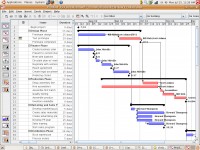Your business relies on technology to quickly and effectively process information. You, your employees and vendors use a variety of means to communicate wit h each other, whether it be VoIP, EDI, email or other means. The longer you have been in business the more electronic information you have to be stored, managed and backed up. Without a disaster plan in place, everything you have worked so hard to establish is at risk.
h each other, whether it be VoIP, EDI, email or other means. The longer you have been in business the more electronic information you have to be stored, managed and backed up. Without a disaster plan in place, everything you have worked so hard to establish is at risk.
Recovery strategies should be developed for Information Technology (IT) systems, applications and data. This includes networks, servers, desktops, laptops, wireless devices, data and connectivity. Priorities for IT recovery should be consistent with the priorities for recovery of business functions and processes that were developed during the first two phases of our process. The first phase being the Network Capabilities Profile (NCP) and the second phase being the Security Readiness Profile (SRP).
Fitting the puzzle together
 During the NCP phase we looked at what changes need to be made at an infrastructure level to provide a solid network foundation. In the SRP phase we worked with you to establish what policies and procedures were missing or what security measures were not implemented that were leaving your business at risk. During this third phase, we sort through all of the information and help you make informed decisions about what to do now or what to do later. If there are pieces of the puzzle that you choose to do nothing about, we will tell you what impact on your business they will have when they become an issue.
During the NCP phase we looked at what changes need to be made at an infrastructure level to provide a solid network foundation. In the SRP phase we worked with you to establish what policies and procedures were missing or what security measures were not implemented that were leaving your business at risk. During this third phase, we sort through all of the information and help you make informed decisions about what to do now or what to do later. If there are pieces of the puzzle that you choose to do nothing about, we will tell you what impact on your business they will have when they become an issue.
Building the budget
 The end result of the Disaster Preparedness Plan phase is a comprehensive list of solutions that need to be addressed in your business. Instituting each of those solutions has a cost. It is in this phase that we assist you in defining which threats the business can tolerate. You can make informed decisions about what the real costs for not doing something are and what the costs will be for you to take action. We developed this process with the understanding that being out of business because of a network or building disaster is not an option. We all may wish for an unlimited budget but that is a luxury that most businesses, do not have. We help you decide what to do first, second or not at all. Having hard costs associated with each piece of the puzzle helps define the next step in the process. That step is laying down a time table for each piece.
The end result of the Disaster Preparedness Plan phase is a comprehensive list of solutions that need to be addressed in your business. Instituting each of those solutions has a cost. It is in this phase that we assist you in defining which threats the business can tolerate. You can make informed decisions about what the real costs for not doing something are and what the costs will be for you to take action. We developed this process with the understanding that being out of business because of a network or building disaster is not an option. We all may wish for an unlimited budget but that is a luxury that most businesses, do not have. We help you decide what to do first, second or not at all. Having hard costs associated with each piece of the puzzle helps define the next step in the process. That step is laying down a time table for each piece.
Setting the timetable
 The first task in formation of your plan is establishing a time frame for implementation. Depending on the size and scope of change needed at your organization, this time frame will extend from weeks to months. Establishing a timeline allows you to sequentially follow the tasks and duties you lay out for all those participating in the plan implementation. It also stimulates action and accountability for everyone involved by creating deadlines by which work must be completed. However, keep in mind that although initial timelines are an aid in your travel toward plan implementation, there can be unforeseen circumstances that alter the dates. Plans should be made for both initial changes and the long-term establishment of disaster recovery as a priority at your organization.
The first task in formation of your plan is establishing a time frame for implementation. Depending on the size and scope of change needed at your organization, this time frame will extend from weeks to months. Establishing a timeline allows you to sequentially follow the tasks and duties you lay out for all those participating in the plan implementation. It also stimulates action and accountability for everyone involved by creating deadlines by which work must be completed. However, keep in mind that although initial timelines are an aid in your travel toward plan implementation, there can be unforeseen circumstances that alter the dates. Plans should be made for both initial changes and the long-term establishment of disaster recovery as a priority at your organization.
If you are ready to get started or would like more information please contact a member of our team at 860.450.1737 or service@pds2k.com today.